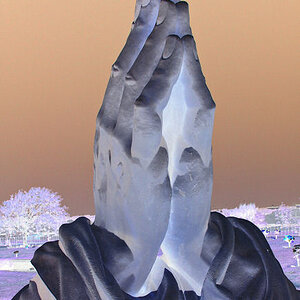Studio7Four
No longer a newbie, moving up!
- Joined
- Oct 5, 2010
- Messages
- 464
- Reaction score
- 62
- Location
- Boston, MA
- Website
- home.comcast.net
- Can others edit my Photos
- Photos OK to edit
Due to some recent discussions in another thread I’ve decided to share some fundamental physics on how lenses work, particularly with regards to sharpest focus. Hopefully a little tutorial will help you understand why your camera does what it does (or, more accurately, why your camera isn’t doing what you think it should be able to do).
Many of you have heard the phrase “focal plane”. That is because lenses work on the principal that the light from one plane refocuses on a parallel plane. For the light to be focusing on your detector plane (whether it is a digital sensor or a film frame), it started in the same plane. Here is a sketch of a simple lens (more complex lenses behave essentially the same way, they’re just better at reducing aberrations):

(In case you trust what you find online more than my simple sketch, check here: File:Lens3.svg - Wikipedia, the free encyclopedia)
As you can see, light which leaves one point on the focal plane – at any angle which passes through the lens – will come back together at a common point on the detector plane. This is the physics of focus.
Note that there are no dimesions in this sketch. By definition a plane extends forever in two dimensions (in this sketch, up/down and in/out of the screen). With a suitably large lens and a suitably large sensor, incredibly large subjects can be captured. But more relevantly, it means that the small portion of that image plane which is your detector is focusing the light from a single plane. Whether you’re using a full-frame or a crop sensor digital camera, or 35mm or a medium- or large-format film camera, if you’re focusing on a plane, that light came from a parallel plane.
Many of you have heard the phrase “focal plane”. That is because lenses work on the principal that the light from one plane refocuses on a parallel plane. For the light to be focusing on your detector plane (whether it is a digital sensor or a film frame), it started in the same plane. Here is a sketch of a simple lens (more complex lenses behave essentially the same way, they’re just better at reducing aberrations):

(In case you trust what you find online more than my simple sketch, check here: File:Lens3.svg - Wikipedia, the free encyclopedia)
As you can see, light which leaves one point on the focal plane – at any angle which passes through the lens – will come back together at a common point on the detector plane. This is the physics of focus.
Note that there are no dimesions in this sketch. By definition a plane extends forever in two dimensions (in this sketch, up/down and in/out of the screen). With a suitably large lens and a suitably large sensor, incredibly large subjects can be captured. But more relevantly, it means that the small portion of that image plane which is your detector is focusing the light from a single plane. Whether you’re using a full-frame or a crop sensor digital camera, or 35mm or a medium- or large-format film camera, if you’re focusing on a plane, that light came from a parallel plane.








![[No title]](/data/xfmg/thumbnail/38/38738-7933157d1b8968c986eeeab2d1828524.jpg?1619738703)


![[No title]](/data/xfmg/thumbnail/37/37621-b86590cf53fc4001d12701ee3091029b.jpg?1619738152)

![[No title]](/data/xfmg/thumbnail/37/37620-c3155da657d8b81637b9050d879694f5.jpg?1619738152)
![[No title]](/data/xfmg/thumbnail/38/38737-350089c7ae87f5c983c5362b9b78b671.jpg?1619738703)




